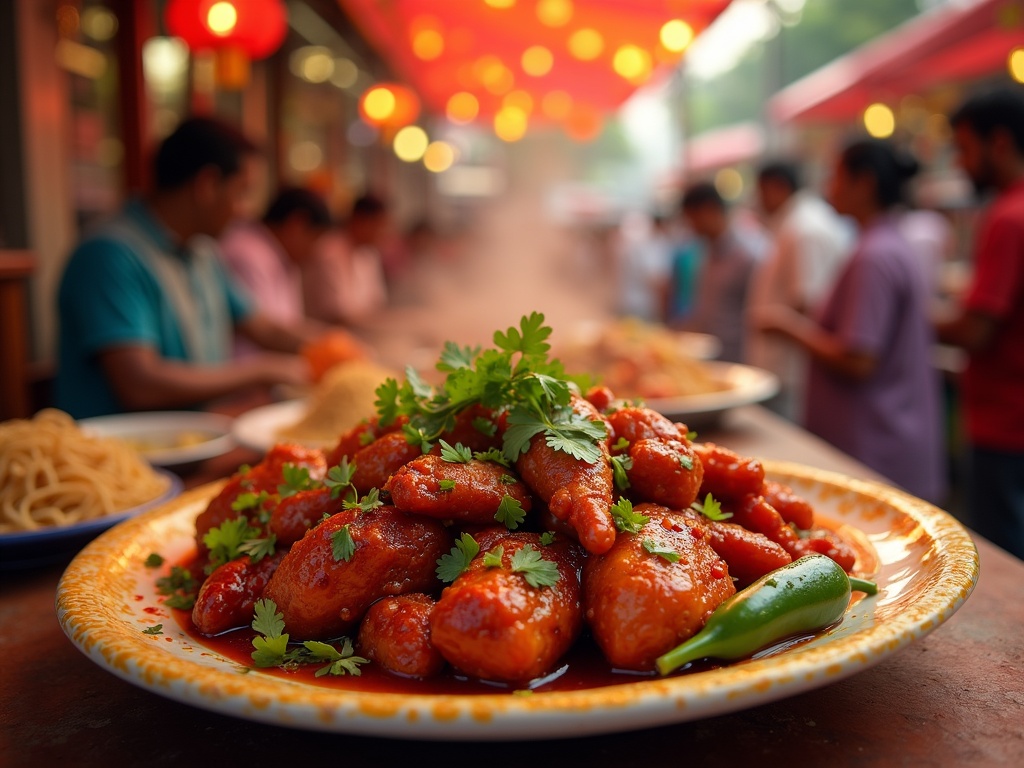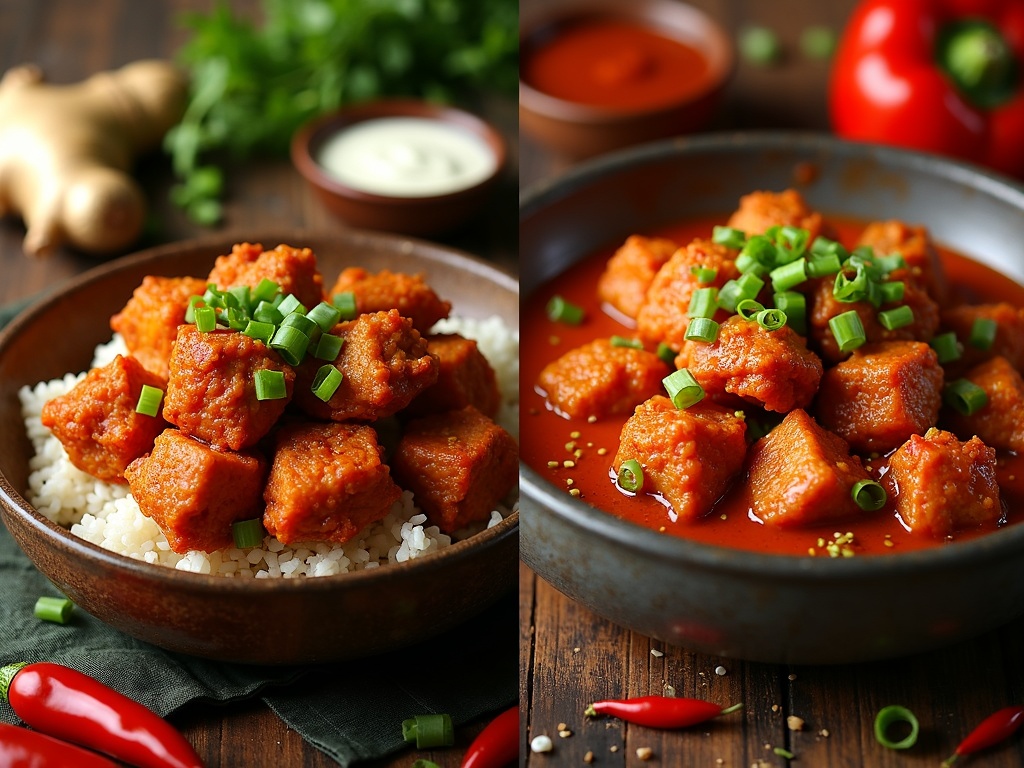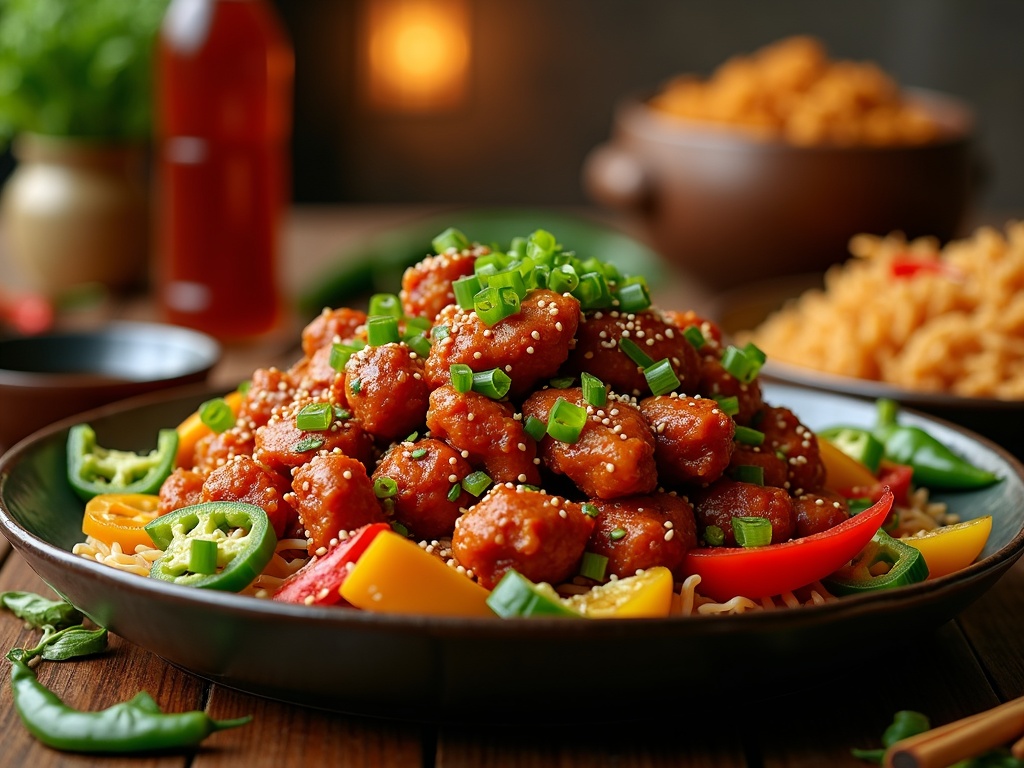Chilli chicken stands as a brilliant fusion dish that blends Chinese cooking methods with Indian spices. Born in Kolkata’s streets, this dish has spread across the globe, delighting food lovers everywhere. It features crispy chicken pieces tossed in a sauce that perfectly balances spicy, sweet, and tangy flavors, available in both dry and gravy versions.
Find In This Article
Key Takeaways
- Chilli chicken originated when Chinese immigrants settled in India, creating a unique fusion cuisine that honors both culinary traditions.
- The dish comes in two distinct styles: a crispy dry version perfect as an appetizer and a saucy gravy version ideal as a main course.
- Proper marination with soy sauce, ginger-garlic paste, cornstarch, egg, and chili is crucial for authentic flavor and texture.
- The dish is adaptable with regional variations found worldwide, from Sichuan-inspired versions to popular chicken wings variations.
- With approximately 310 calories and 25g of protein per serving, chilli chicken offers a relatively balanced nutritional profile compared to many other takeout options.
The Birth of Indian-Chinese Fusion
The flavorful journey of chilli chicken began with Chinese immigrants who settled in India during the 19th and early 20th centuries. This migration sparked one of the most delicious culinary marriages in food history. Chinese workers and traders, particularly in Kolkata (formerly Calcutta), brought their cooking techniques and ingredients, which gradually merged with local Indian flavors to create something entirely new.
A Perfect Cultural Blend
This fusion wasn’t just about combining ingredients—it represented a beautiful cultural exchange between two ancient civilizations. Chinese cooking methods like stir-frying and deep-frying met India’s bold spice palette, creating dishes that honored both traditions while being uniquely different from either parent cuisine.
Chilli chicken quickly rose to prominence as a must-have appetizer and main course in Indian restaurants. I’ve noticed how this dish bridges cultural gaps, appearing on menus from high-end establishments to street food stalls across India. The dish features:
- Classic Chinese seasonings like soy sauce, garlic, and ginger
- Indian-inspired elements like green chilies, cumin, and garam masala
- A cooking approach that combines Chinese stir-frying with Indian spice tempering
- Variations that range from dry preparations to gravy versions
The cultural significance of chilli chicken extends beyond its delicious taste. It stands as one of the first truly successful fusion dishes that gained widespread acceptance across different communities. Unlike many modern fusion experiments, chilli chicken evolved naturally through decades of cultural intermingling rather than being created as a chef’s novelty.
Today, I can’t help but appreciate how chilli chicken has become a gateway dish introducing many to the broader world of Indian-Chinese cuisine. This style of cooking has grown to include favorites like Manchurian dishes, Hakka noodles, and simple chicken recipes with hot garlic sauce.
The beauty of chilli chicken lies in its adaptability—each region of India has put its own spin on the dish. In some areas, you’ll find it fiery hot, while in others, there’s a sweeter profile. Some chicken recipes borrow techniques from traditional Indian cooking, while others stay closer to Chinese methods.
This delicious cultural crossover continues to evolve, proving that chicken dishes can transcend borders and bring people together through shared culinary experiences.

Master the Art of Chilli Chicken
I’ve discovered that creating restaurant-quality chilli chicken at home isn’t as challenging as it might seem. This popular Indo-Chinese dish comes in two distinct styles, each offering its own delightful experience. Let me guide you through mastering both versions in just 20-30 minutes of cooking time.
Dry vs. Gravy: Understanding the Difference
The dry version of chilli chicken delivers a wonderfully crispy exterior with minimal sauce coating each piece. It’s perfect as an appetizer or snack when you’re craving something with a satisfying crunch. The pieces are typically coated in a cornstarch batter before frying, creating that signature crispiness that pairs beautifully with the spicy flavors.
The gravy version, on the other hand, features the same flavorful chicken but swimming in a rich, velvety sauce base. This style works brilliantly as a main course served over rice or noodles. The sauce soaks into the accompanying starches, creating a complete meal that’s packed with flavor. If you enjoy the tender chicken and sauce combination found in chow mein, you’ll likely appreciate this style.
Essential Techniques for Perfect Chilli Chicken
Marination is absolutely crucial when making chilli chicken. I always marinate my chicken pieces for at least 30 minutes before cooking, though longer is better if you have time. The standard marinade includes:
- Soy sauce for that umami depth
- Ginger-garlic paste for aromatic foundation
- Cornstarch for crispiness
- Egg for binding
- Red chilli powder or paste for heat
The cooking method depends on which version you’re making. For the dry version, I prefer deep-frying the marinated chicken pieces until golden brown and crispy. This creates that perfect crunch that makes dry chilli chicken so addictive. For a lighter alternative similar to simple chicken breast recipes, you can also air-fry the pieces.
For the gravy version, I usually stir-fry the chicken first, then create a sauce separately before combining them. The high-heat stir-frying method is essential for both styles as it locks in the flavors and creates the perfect texture. The sauce typically contains soy sauce, vinegar, chilli paste, and sometimes a touch of ketchup for sweetness.
The final touch that elevates homemade chilli chicken is garnishing with freshly chopped spring onions. They add a bright, fresh flavor that contrasts beautifully with the rich, spicy dish. If you enjoy working with chicken in different preparations, you might also like creating a hearty chicken pie or chicken lasagna for variety in your meal planning.
Both styles of chilli chicken pair wonderfully with fried rice or noodles, making them versatile options for dinner. For those who enjoy crispy chicken with different flavor profiles, trying your hand at fried chicken recipes or even a chicken Kiev can expand your cooking repertoire using similar techniques.
The beauty of chilli chicken is in its balance of heat, sweetness, and tanginess. Once you’ve mastered the basic recipe, you can adjust the spice levels and sauce consistency to your preference, making it truly your own signature dish.

What Makes it Special: Variations and Global Appeal
Chilli chicken isn’t just a dish—it’s a global phenomenon with countless variations that have captured the hearts and palates of food lovers worldwide. I’ve seen this versatile chicken dish evolve remarkably as it travels across borders, each region adding its unique twist.
Popular Variations and Trending Appeal
The beauty of chilli chicken lies in its adaptability. Sichuan Chilli Chicken offers a more authentic Chinese experience with its numbing peppercorns and deep, complex heat that builds with each bite. On the other hand, Chilli Chicken Wings have become a party favorite, perfect for game days and casual gatherings where the spicy coating clings to every crispy wing.
This dish has gained impressive traction in Western countries, particularly in:
- USA, where it’s become a staple in fusion restaurants
- UK, where it’s a favorite late-night takeaway option
- Canada, where diaspora communities have introduced it to mainstream food culture
What’s fascinating is how chilli chicken has found a new audience through social media. Food bloggers and influencers regularly feature this vibrant dish in their content, with sizzling videos of the cooking process attracting millions of views. The visual appeal of the glossy sauce coating the crispy fried chicken pieces makes for perfect food content that appeals to younger demographics.
I love how versatile this dish is—you can adjust the heat level, switch up the vegetables, or play with different sauce thicknesses. Some people prefer a drier version with just enough sauce to coat the chicken, while others enjoy a more gravy-like consistency perfect for scooping up with homemade breads or spooning over rice.
For a complete meal, chilli chicken pairs wonderfully with fried rice, creating a balanced combination of protein and carbs. In fusion settings, it’s often served with naan bread—a testament to how this dish crosses culinary boundaries between Chinese and Indian cuisines. The Chinese-inspired flavors complemented by Indian spices create a unique taste profile that’s greater than the sum of its parts.
What starts as a simple chicken recipe transforms into an endlessly customizable dish that reflects personal taste and cultural influences—making chilli chicken not just a meal, but a culinary canvas for creative expression.
Chef’s Secrets for Perfect Results
I’ve spent years perfecting my chilli chicken recipe, and there are several key techniques that make the difference between an average dish and a restaurant-quality masterpiece. The beauty of this Indo-Chinese favorite lies in its balance of heat, flavor, and texture—all achievable at home with the right approach.
Essential Techniques for Restaurant-Quality Results
Starting with fresh chicken pieces makes a significant difference in the final dish. I always choose boneless thighs rather than breast meat when possible, as they remain juicier after frying. For the best results, cut the chicken into consistent 1-inch cubes to ensure even cooking.
Marination is perhaps the most critical step that many home cooks rush. The perfect chilli chicken requires at least 30 minutes (though 2-4 hours is even better) with a precise spice blend. I combine cornstarch, egg, black pepper, and a touch of soy sauce to create a coating that becomes exceptionally crispy when fried.
The signature crispiness of chilli chicken demands high-heat cooking—no exceptions. I heat oil to about 350°F (175°C) and fry in small batches to maintain the temperature. Overcrowding the pan causes temperature drops and results in soggy chicken.
For the perfect flavor profile, I’ve found these elements create the ideal balance:
- A mixture of red chilli powder and Kashmiri chilli powder (for color without excessive heat)
- Dark soy sauce (for depth) combined with light soy sauce (for saltiness)
- Fresh ginger-garlic paste rather than pre-made versions
- A touch of vinegar to brighten the flavors
- Spring onions added at different stages—white parts for cooking, green tops for garnish
For those who prefer the gravy version of chilli chicken, achieving a crystal-clear sauce requires careful technique. I mix cornstarch with cold water before adding it to the hot pan, and I stir continuously in one direction to prevent cloudiness.
Timing is everything when combining the fried chicken with the sauce. I add the chicken to the sauce just before serving to maintain that perfect texture contrast—crispy exterior with juicy interior. If added too early, the chicken absorbs too much liquid and loses its crunch.
Many restaurant chefs finish their chilli chicken with a quick toss in hot oil with dried red chilies and curry leaves for an aromatic finish. This final step elevates the dish from good to exceptional.
With these techniques, I’ve been able to create chilli chicken that rivals my favorite restaurants. The combination of proper marination, high-heat cooking, balanced spices, and careful timing transforms this classic into a showstopper dish worth mastering.
Know Your Nutrition
Delving into the nutritional profile of chilli chicken helps me understand why it’s both satisfying and something to enjoy mindfully. This flavorful dish packs quite a nutritional punch while remaining relatively balanced compared to many other takeout options.
Nutritional Breakdown
A standard serving of chilli chicken (approximately 150g) contains about 310 calories, making it a moderate calorie option for a main protein dish. The 25g of protein per serving explains why I feel satisfied after eating it – that’s roughly half the daily protein requirement for many adults. The dish contains 18g of fat, which contributes to its rich taste and mouthfeel, while the 10g of carbohydrates are relatively modest compared to many other Asian-inspired dishes that might be served with rice or noodles.
One aspect to be mindful of is the sodium content – at 800mg per serving, it represents about one-third of the recommended daily sodium intake. This higher sodium level is typical of many restaurant-style chicken breast recipes that use soy sauce, salt, and other flavor enhancers.
Preparation Variations
The nutritional profile of chilli chicken can vary significantly based on how it’s prepared:
- Deep-fried versions typically contain more fat and calories than stir-fried alternatives
- Restaurant preparations often contain more sodium than homemade versions
- Adding vegetables to the dish increases fiber and nutrient content
- Using skinless chicken breast instead of thigh meat reduces fat content
- The amount of sauce can significantly impact carbohydrate and sodium levels
I’ve found that making chilli chicken at home allows for better control over ingredients, particularly oil and sodium. For example, opting for a light stir-fry technique rather than deep-frying can reduce the fat content by up to 50%.
The high protein content (25g per serving) makes chilli chicken a filling option that helps maintain muscle mass and provides lasting energy. This is comparable to other protein-rich dishes like fried chicken, though typically with less breading and therefore fewer carbohydrates.
For those watching their sodium intake, there are several ways to enjoy this dish more moderately:
- Request less sauce when ordering at restaurants
- Prepare homemade versions using low-sodium soy sauce
- Balance the meal with plain rice or steamed vegetables to dilute the overall sodium content
- Limit portion sizes to a single serving rather than consuming multiple portions
The nutritional balance of chilli chicken makes it a versatile dish that can fit into various eating patterns. Its protein-to-carbohydrate ratio is particularly favorable for those following lower-carb eating plans, especially when compared to dishes like chicken lasagna which typically contains significantly more carbohydrates.
For a more complete meal, I often pair chilli chicken with steamed vegetables or a small portion of brown rice, creating a balanced plate while still keeping the overall calorie count reasonable. This approach turns this flavorful dish into a center point of a nutritious meal rather than a guilty pleasure.

Sources:
Fusion Foods of India: The Chinese Influence by Priya R. Sharma
Chili Chicken Recipe: Traditional Meets Modern in Culinary India Magazine
Nutrition Facts for Chilli Chicken by Healthline Nutrition Guide
Global Trends in Indian Dishes by World Food Journal

